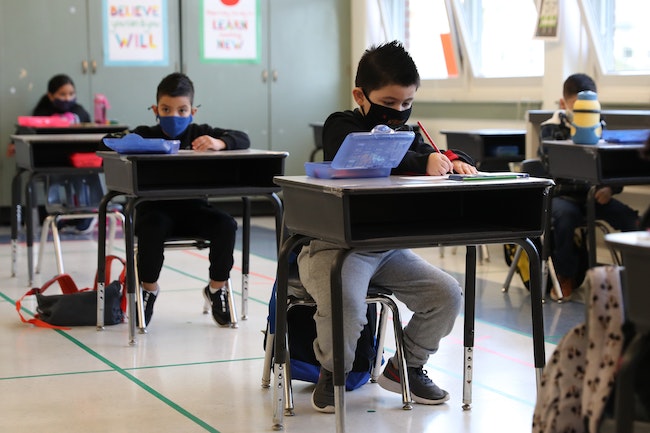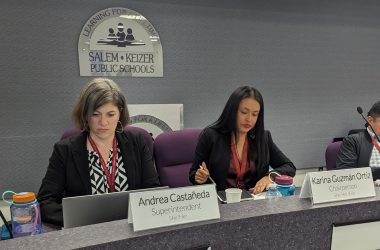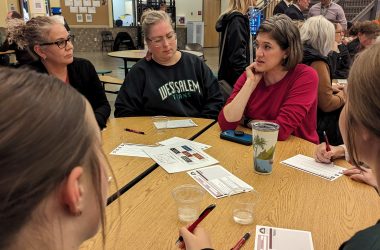
Giovanni Fajardo Perez, a student in Crystal Magee’s kindergarten and first grade classroom, uses colored pencils on the first day back to school at Richmond Elementary on Tuesday, March 2. (Amanda Loman/Salem Reporter)
The vast majority of elementary school families opted to send their kids back for in-person classes in the Salem-Keizer School District, with nearly 14,000 students attending in-person regularly by the end of last week.
District data provided to Salem Reporter shows about 80% of the district’s elementary students have returned to buildings three weeks after local schools began phasing in in-person classes starting with kindergarten and first graders on March 2. Fourth and fifth graders resumed in-person school last week.
Most of the elementary students currently attending school online, about 3,000 in total, were previously enrolled in EDGE, Salem-Keizer’s all-online program created at the start of the school year. The acronym stands for Enhanced Digital and Guided Education.
District administrators set up the program as part of their response to the Covid pandemic, billing it as the best option for families who preferred to remain online all year even if state regulations and the pandemic’s trajectory made in-person classes possible.
Some families signed up because of members at high risk for Covid, while others said they wanted the stability of knowing their students wouldn’t be changing schooling formats midway through the year.
About 500 students, or 3% of total elementary school enrollment, transferred into the EDGE program following the district’s announcement that elementary schoolers would head back into classrooms earlier this year.
“We were pleasantly surprised that we didn’t have a huge number of kids wanting to transfer to EDGE or to a digital platform. We’ve had overall really strong support for coming back to a hybrid model of some sort,” said Kraig Sproles, assistant superintendent.
He said about 80 families also transferred students out of the EDGE program so they could return to in-person classes, though whether families had that option depended on capacity at individual elementary schools.
(Graphic by Rachel Alexander/Salem Reporter)
Overall, the racial demographics of elementary students enrolled in EDGE mirror the district’s makeup, with the exception of Asian students. They account for 2% of all elementary students but 4% of elementary EDGE students.
Recent transfers to the online program – reflecting families who didn’t want to send kids back in-person – showed a slightly higher share of Latino and Asian families.
Of the elementary students who moved online in recent weeks, about half are Latino, while 34% are white. Salem-Keizer’s elementary school enrollment is 46% Latino and 41% white.
Sylvia McDaniel, the district’s director of community relations, said she believes those numbers reflect the disproportionate impact the pandemic has had on Latino families.
Students and young adults with Latinos Unidos Siempre raised that concern in a protest outside the district office in early March, saying reopening schools put their families at higher risk, particularly when vaccinations were not available to most frontline workers in Oregon.
“Families move their students to EDGE because they are not comfortable with their child coming back in person,” McDaniel in an email. “They have lost loved ones, therefore, have been greatly impacted by COVID-19 and therefore do not wish to return in person.”
Asian students were also more likely to transfer online, accounting for 5% of recent transfers but just 2% of the district’s elementary school enrollment.
The numbers stand in contrast to some of the largest school districts in the U.S., including Chicago and New York, where a majority of families opted to remain online when given the choice to return. Those districts also recorded much larger gaps in willingness to return to in-person school between white students and their Black and Latino peers.
“It’s not horribly out of proportion, which I think is a testament to how well we’ve tried to work with our community based organizations to get the word out,” Sproles said.
He said the district has worked with education-focused community organizations like the Salem-Keizer Coalition for Equality, a Latino parent advocacy group, to share information about resuming in-person class and the safety protocols in place.
In Salem-Keizer, families who wanted to remain online had to opt out by contacting a school administrator, and in most cases switching their child to a new teacher.
Sproles said child care arrangements played a role for some families opting to remain online. In-person classes are currently two days per week, five and a half hours per day, which means parents working full-time still need child care before or after school, as well as on days when school is held online.
“This was a big logistical change, more for our elementary families,” he said.
Some found existing arrangements with pods, relatives or daycares were easier to keep without changing the school schedule, he said.
Local schools are on spring break this week and scheduled to resume Monday. Middle and high school students will resume in-person classes part time starting April 13.
Contact reporter Rachel Alexander: [email protected] or 503-575-1241.
Salem Reporter counts on community support to fund vital local journalism. You can help us do more.
SUBSCRIBE: A monthly digital subscription starts at $5 a month.
GIFT: Give someone you know a subscription.
ONE-TIME PAYMENT: Contribute, knowing your support goes towards more local journalism you can trust.

Rachel Alexander is Salem Reporter’s managing editor. She joined Salem Reporter when it was founded in 2018 and covers city news, education, nonprofits and a little bit of everything else. She’s been a journalist in Oregon and Washington for a decade. Outside of work, she’s a skater and board member with Salem’s Cherry City Roller Derby and can often be found with her nose buried in a book.









